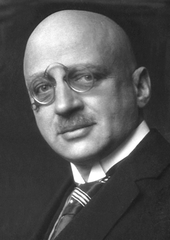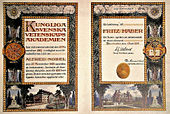Fritz Haber
![]()
This article describes the chemist. For the space engineer see Fritz Haber (space engineer).
Fritz Jakob Haber, also Fritz Jacob Haber (born 9 December 1868 in Breslau; † 29 January 1934 in Basel) was a German chemist and Nobel laureate in chemistry. He was the founding director for 22 years of the Kaiser Wilhelm Institute for Physical Chemistry and Electrochemistry in Berlin, which is now named after him. His scientific work includes contributions to thermochemistry, organic chemistry, electrochemistry and technical chemistry. Together with Max Born, Haber developed the Born-Haber circular process for the quantitative determination of the lattice energy in crystals.
Together with Carl Bosch, he developed the Haber-Bosch process for the catalytic synthesis of ammonia from the elements nitrogen and hydrogen. This enables the mass production of nitrogen fertilizer and thus ensures the nutrition of a large part of today's world population. He was awarded the 1918 Nobel Prize for Chemistry for this achievement.
Haber's experiments with phosgene and chlorine gas shortly after the start of the First World War made him the "father of the gas war". Under his leadership, the German gas troops were formed and later poison gas was used as a weapon of mass destruction for the first time. Later, he researched the possibilities of extracting gold from seawater in order to finance German reparations after the First World War.
After the National Socialists came to power, Fritz Haber emigrated to England in 1933 due to reprisals on account of his Jewish ancestry. He died a few months later in a hotel in Basel.

Fritz Haber, 1918
Honors and awards
Designations
In his honor, the Kaiser Wilhelm Institute for Physical Chemistry and Electrochemistry was renamed the Fritz Haber Institute of the Max Planck Society. The library of the Weizmann Institute is named after Haber, and the Fritz Haber Center for Molecular Dynamics was founded at the Hebrew University of Jerusalem in 1981.
The lunar crater Haber is named after him.
Awards
- Foreign member of the American Academy of Arts and Sciences (1914)
- Liebig memorial coin of the Association of German Chemists (1914)
- Corresponding member of the Bavarian Academy of Sciences (1917)
- Member of the Göttingen Academy of Sciences (corresponding member since 1918, external member since 1927)
- Nobel Prize for Chemistry (1918)
- Bunsen Medal of the German Bunsen Society for Physical Chemistry, together with Carl Bosch (1918)
- President of the Society of German Chemists (1923)
- Harnack Medal of the Kaiser Wilhelm Society (1926)
- Wilhelm Exner Medal (1929)
- Honorary member of the Société Chimique de France (1931).
- Honorary member of the Chemical Society of England (1931).
- Honorary member of the Society of Chemical Industry, London, (1931).
- Rumford Medal, American Academy of Arts and Sciences (1932)
- Foreign member of the National Academy of Sciences, USA (1932)
- Honorary member of the Russian Academy of Sciences (1932)
- Executive Committee of the International Union of Pure and Applied Chemistry, 1929 to 1933; Vice-President, 1931
- Goethe Medal for Art and Science
Since 1959, the German Bunsen Society for Physical Chemistry has awarded the "Nernst-Haber-Bodenstein Prize" for outstanding scientific achievements of young researchers in the field of physicalchemistry.

Nobel Prize certificate
Writings
- Grundriss der technischen Elektrochemie auf theoretischer Grundlage. R. Oldenburg, Munich 1898.
- Thermodynamics of technical gas reactions. R. Oldenbourg, Munich 1905.
- with E. Ramm, N. Caro: From air through coal to nitrogen fertilizer, bread and abundant food. R. Oldenburg, Munich 1920.
- Five lectures from the years 1920-1923. J. Springer, Berlin 1924. urn:nbn:en:urmel-69458e90-bcd0-4480-9e11-56f2d6f6c5760
- From life and profession. Essays, speeches, lectures. J. Springer, Berlin 1927.
Search within the encyclopedia